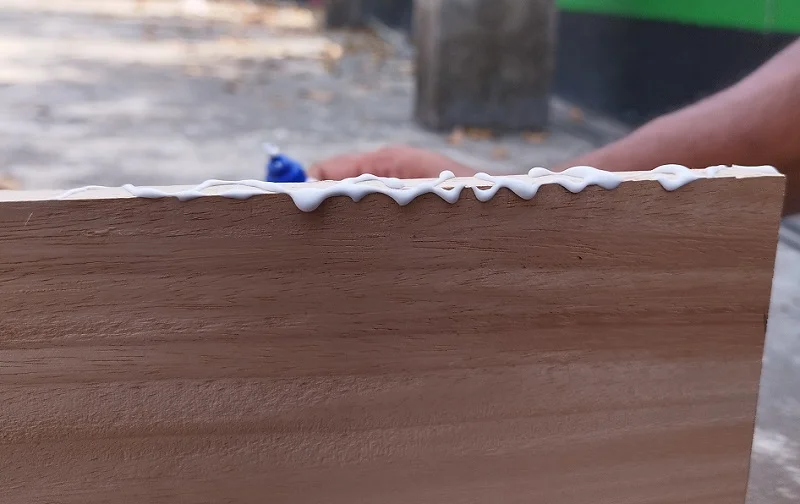
If you are someone who enjoys designing the exterior of the house more than the interior, you know that pressure-treated wood is a blessing! On a hunt for this blessing, that is exactly how I found myself tangled between websites. The only question on my mind is how the wood is going to stay put. Can I glue pressure-treated wood?
The answer is yes! Once the wood is treated, it has a lot of chemicals and is damp. You will face challenges, especially because of the exposure. Polyvinyl and yellow urea resin glues are the adhesives you should be looking for!
Choosing which glue will be best suitable can be a challenge. But you need not worry, as I am here to provide you with all the information you need for your next outdoor project.
Can you glue pressure-treated wood? The Best Glue For Processed Wood
Like other materials, you need special glue for pressure-treated wood. Traditional glue might not work if you are looking for a long-term effect.
Polyurethane and yellow are the best options. They resist hard situations like damp conditions without falling apart.
The best glue to use on pressure-treated wood:
As pressure-treated wood is mostly used for external and ground contact, it needs an adhesive that is strong and has PU-based components.
You should consider a few factors before buying a resin adhesive for your pressure-treated wood.
- It should be versatile and easy to work on any textured surface. Most wood glues leak once applied, so choose a glue that is easy to handle.
- Look for nozzle tip glue, as they help you maintain the amount of glue you use. You can avoid making a mess and get to small areas easily.
- Check for the curing time of the glue. Some glues take 30 minutes, while others need a whole day.
- You also need to make sure it is heat and water-resistant. This depends on your project, but this is one of the most important characteristics to check in any adhesive.
Once you have jotted down all the requirements, the hunt for the best glue begins. I have made it easier for you!
Here are a few types of glue that work great on pressure-treated wood, and where you can buy them:
| Glue | Key features | Where to buy |
| Gorilla Original Waterproof Polyurethane Glue | Temperature resistant, waterproof, super strong, versatile | Buy here |
| Titebond III Ultimate Wood Glue, Quart | Waterproof, Superior strength, easy to use | Buy here |
| Titebond Cross-Linking Polyvinyl Acetate Wood Glue | Heat and water-resistant, durable, non-toxic | Buy here |
| Titebond Original Wood Glue, Yellow | Incredibly strong, easy to use, fast curing | Buy here |
| C-TOUGH Epoxy Adhesive C-TOUGH by CECCORP | Scratch-resistant, Durable, Fast gelling time | Buy here |
| Roberts Indoor/Outdoor carpet glue for pressure-treated plywood | Moisture control adhesive, Fast curing time, non-flammable | Buy here |
| Gorilla wood glue for pressure-treated lumber | Easy application, super adhesive strength, waterproof | Buy here |
Can you glue pressure-treated wood to concrete?
Pressure-treated wood can be glued to concrete using construction adhesives and sealants. It is also recommended as pressure-treated wood creates protection against rot and insect damage.
There is a way to attach pressure-treated wood to concrete that can increase the longevity of the bond. That way; you won’t have to glue the wood again for a while.
Here are the tools that you’d need to attach the pressure-treated wood to concrete:
- Concrete or cut nails
- A Hammer
- Hardened screws
- Masonry drill bit
- Toggle Bolts
- Heavy-duty anchors- steel anchors and matching lag screws
- CT1 Hybrid polymer adhesive
Note: These are the items you require if you are using an alternate way to glue or adhesive.
Using adhesive to attach the wood to concrete can be done differently depending on your type of adhesive. Some glue requires the concrete to be dry, while others require it to be dry.
Depending on the adhesive, the application also varies. You might need to put the adhesive on both the concrete and the wood.
Evenly apply the glue on the surface. Using a pencil, mark where the glue will be on the concrete to avoid wasting it.
Then tap out all the air bubbles from the adhesive Once that is done, press the wood on the concrete and compress it using a wedge.
You can now leave it dry for 8 to 24 hours. The longer you leave it to cure, the stronger the bond will be.
Can you use gorilla glue on pressure-treated wood?
Yes, you can use gorilla glue on pressure-treated wood. Gorilla glue is a waterproof adhesive and is strong enough for outdoor projects.
A product review by newwoodworker.com says that Gorilla glue is “a good choice for many hardwood projects.”
A video review by “HandyTF” shows a comparison between Gorilla glue and Titebond. They carried out a test to see which glue was stronger on pressure-treated wood.
After a lot of research about which glue works best on pressure-treated wood, he narrowed it down to these two types of glue, Gorilla and Titebond.
After applying them both on different pieces of lumber, he left them to cure overnight. Gorilla glue gave a better result as it couldn’t break apart by hand.
How to glue pressure-treated wood (Step-By-Step Guideline)
Before using glue on pressure-treated wood, you need to make yourself aware of the process of the treatment.
As the chemicals are infused in the wood, using certain adhesives might be hard through different pressure treatments. But it is not at all impossible.
You need to have the following items at hand:
Things You Need:
- Glue
- Dust mask or respirator
- Gloves
- Clean rag
- Roller
- Sandpaper
- Planer
- Shop vacuum
- Tack cloth
- Mild dish soap
- Water
Once you have all the material, you can follow the step-by-step guide for how to glue pressure-treated wood.
Easy 6 Step-by-step Process To Follow:

Step 1: Prepare the Surface
The first and foremost thing to do while preparing the wood is clean it so no contaminants linger on the surface.
For that mix, dish washes soap with water and use a clean rag to wipe the surface with the mixture.
Repeat the process until the rag comes clean when you wipe the surface. Make sure to dry the surfaces thoroughly before putting glue on them!
After that, make sure the surface is even. If they are not, you can use sandpaper to even it out. Remember only to sand lightly! Over-sanding can strip the protective chemical layer on the surface.
Step 2: Apply the glue
Once you have prepared the surfaces, you can squeeze out the glue on whichever part you want to attach. There is no right or wrong way to apply glue, just don’t pour the whole tube out.
Step 3: Spread the glue and attach the two pieces of treated wood
You can either use the same piece you want to attach to spread out the glue or you can use a roller to evenly spread out the glue on the surface. Once the glue has covered every inch of the treated glue you want to attach, you can place the two pieces together.
Step 4: Clamp the glued pieces
To enhance the bonding, you need to hold the two pieces together. Once the wood pieces are aligned, you can use any suitable size to hold the pieces tightly till the glue is cured.
Step 5: Remove the excess glue squeezed out
Once you clamp the pieces together, the excess glue will ooze out. You can remove it easily using a damp rag while the glue is still fresh. But once it dries, you can also use a plastic scraper to get rid of the excess.
Step 6: Allow the bond to dry for maximum strength
Once everything is done nicely and safely, it should take about 24 hours for the glue to dry. If you are not in a rush with your project, you can leave it out for longer.
The best glue to use on treated lumber
Polyurethane-based glue is the best for treated lumber. Original Gorilla Glue has a polyurethane formula, which is a water-resistant adhesive.
The formula expands into the material and makes a strong bond between the surfaces. According to a Twitter user, it is a “glue, especially for treated lumber.”
FAQs
Gorilla glue is specifically manufactured for hardwood projects. It is labeled as ‘non-toxic.’ Make sure not to ingest it.
You can glue pressure-treated wood to almost anything. The longevity and the type of glue vary from material to material.
The adhesive should be about one-eighth thick. If it oozes out, you can still wipe the excess with a damp rag.
The cure time is about 8 to 24 hours. The longer you leave it to dry, the stronger the bond will be
Nailing the wood is not required if you have already glued the surfaces. You can hold the pieces together using a clamp or painter’s tape till it is cured.
Yes, you can if you want to permanently bond the pieces together.
Conclusion
Gluing has never been easier. With a little research, you can find all the products you need for your projects, small or big. There are a lot of amazing glues out there that serve the purpose.
In my opinion, Gorilla glue is the best. Seeing as it is very versatile and can be used on any surface if you have it at hand, you can fix anything. Without the fear of it breaking apart.

